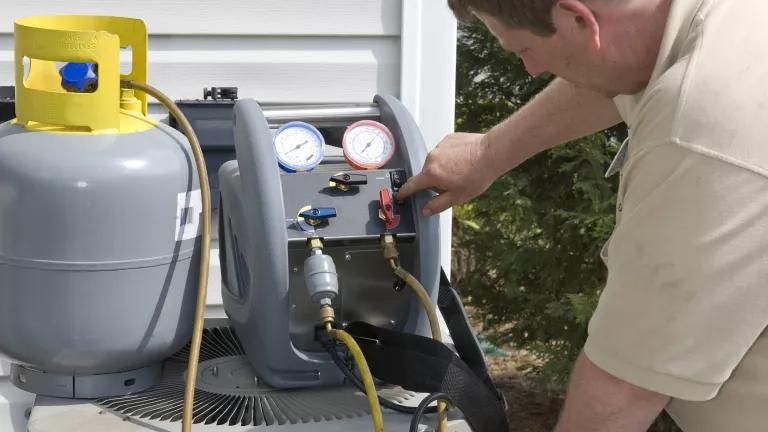Sustainable FERC 2022: The Good, the Promising, and the Unfortunately Predictable
FERC and regional grids made important strides this year making markets fairer for clean energy and the electricity system more resilient and secure.

Part of NRDC’s year-end series reviewing 2022 climate and clean energy developments
This past year saw a meaningful shift in the decisions and outlook of the Federal Energy Regulatory Commission (FERC) as it firmly followed through on a decision to stop favoring fossil fuel plants in electricity markets and took a small, hesitant step toward reviewing gas pipeline project applications in the way the law demands.
Regional power grid operators and states took historic action to build new transmission lines, give demand response more economic value, connect grids across regions, and coordinate in a way that will allow offshore wind to thrive along the Atlantic seashore.
The Sustainable FERC Project and its partners played an important role in each of these areas and will be doing more in the years ahead to bring the promising steps this year to fruition.
Next year, FERC needs to follow through with strong, long-overdue standards to get more transmission lines built and more clean energy out of the interconnection waiting room and connected to regional grids. Regional grid operators have been falling further and further behind in getting many hundreds of clean energy projects connected to the grid; FERC needs to act now on its planning and interconnection rules to help remove these barriers.
The good
- Midwest grid operator approves largest set of transmission projects in the history of the United States. In July, MISO, the grid operator for the Midwest and middle South, approved nearly $10.5 billion in new transmission projects, the largest set of projects ever approved in a single action. Over 40 years, the net financial benefits of these projects for consumers will amount to between $23 billion and $52 billion dollars in fuel, energy market, and avoided carbon pollution, and they will lower blackout risks. The projects will open the door to an estimated 53 gigawatts of new wind, solar, and storage projects—enough to power 12 million homes. Connecting these resources will avoid 20 million tons annually of carbon pollution between 2030 and 2050. Building these new transmission lines and renewable projects will create around 330,000 jobs.
- Northeastern states accelerate collaboration on offshore wind build-out. Recognizing the benefits of offshore wind, states along the East Coast are starting to add more offshore wind to their energy mix. However, until now, states and the federal government have not really considered how to best bring this clean power onshore in ways that minimize consumer costs and increase the grid’s resiliency and reliability. Thankfully, this is beginning to change. This fall, northeastern states initiated a process to collaboratively plan to integrate significant amounts of offshore wind into their regional grids. Similarly, the U.S. Department of Energy is currently conducting a study examining transmission options to support new wind projects along the East Coast.
- Power grids across the nation prepare for rooftop solar and other distributed energy resources. Over the course of the year, grid operators moved to comply with FERC’s 2020 order mandating a technology-neutral approach to small, distributed electricity resources. These rules open the door for smart buildings and electric vehicles to participate financially in electricity markets, saving consumers money and providing a major new resource of resilience and reliability to grids. These rules include guarantees that local and federal programs work in coordination and ensure utilities can’t obstruct or monopolize demand response resources.
- FERC protects clean resources from NYISO’s Buyer-Side Mitigation rules. In May, FERC approved changes to the New York grid operator rules that exclude clean resources—which further the goals of New York State’s climate goals—from potentially damaging wholesale power market rules (aka “buyer-side mitigation”). In effect, this means that solar, wind, and battery storage can better compete with polluting plants in the New York grid’s capacity markets, which will both spur new clean resources and save consumers money on their energy bills, as much as $460 million in 2030.

Still pending
- FERC proposed four different rules that would help clear the backlog of projects waiting to connect to the grid, help cut through the unnecessary delays for transmission projects, and put the utility industry in a better position to plan for and withstand extreme weather. FERC will need to finalize these rules in 2023 and the Sustainable FERC Project has been urging the agency to set clear rules for regional grid operators so that these problems in the connection queue and building new transmission lines don’t persist. One more new rule on transmission planning is scheduled to be voted on in FERC’s last meeting of the year.
- With proposals to expand power market services to western states advancing on two fronts, utilities from Oregon to Arizona are weighing the prospect of becoming part of an organized electricity market. A new study showed that an integrated western grid could save electricity customers in that region a whopping $2 billion a year on their bills. In addition, California’s grid operator, CAISO, proposed establishing an Extended Day-Ahead Market, which would be a voluntary market designed to increase regional coordination, encourage the development of renewable energy resources, and lower costs for consumers. The plan, if agreed to, could be implemented as early as 2024.
- On gas policy, FERC took one (long-overdue) step forward, but then quickly retreated. Given the legal requirement that FERC consider the full environmental impacts of gas pipelines and export facilities before establishing a valid need for those projects and approving them, FERC will need to act and finalize a new gas policy in the coming year. (For all the ins and outs on FERC and gas, please see this blog from Gillian Giannetti and Morgan Johnson.)
The sadly predictable
Last year, when Winter Storm Uri hit Texas and catastrophically knocked power out in the state for days and days, a predictable cadre of fossil fuel defenders took the airwaves to blame new energy—specifically wind—for the state’s woes. There was only one problem with this argument: It was entirely backward. As subsequent analysis from FERC and the North American Reliability Corporation showed, natural gas supply-related issues were responsible for 87 percent of the outages during the Texas storm.
We continue to see these same disingenuous arguments whenever extreme weather affects the grid. What we have learned in storm after storm is that no one power source is perfect: coal piles freeze, gas lines stop flowing, and nuclear plants need to shut off as a storm approaches. We’re now seeing that even extreme heat can force coal or nuclear plants offline. And, yes, the sun doesn’t shine at night and the wind doesn’t always blow.
At the Sustainable FERC Project, we recognize that no one power source is perfectly reliable: A large, integrated grid with plenty of different power sources (including distributed energy resources) and the necessary investments in transmission lines across the country can deliver a nimble, reliable power system, one that helps us address the climate crisis currently before us while becoming more resilient to the extreme weather we can expect in the future because of climate change.
By advocating for the policies that will lead to more clean energy connected to the grids, more connections across regional grids, and more large-scale transmission lines to carry that new energy, we are doing the hard, meaningful work necessary to transition to a cleaner, stronger future.
Stay tuned: There’s much more to come in 2023!




